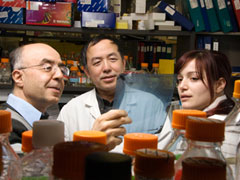Seems Like a Bind
By Jim Oldfield
Readers drawn to the journal Blood for the simplicity or dramatic portent of its title—despite apparent promise in articles such as, "Attack of the CD4 clones" and "RAGs found ‘not guilty': cleared by DNA evidence"—will soon find themselves in a surprisingly complex genetic thicket.
Consider this recent contribution from Dr. Yaacov Ben-David, a senior scientist in molecular and cellular biology at Sunnybrook Research Institute: "Retroviral insertional activation of the Fli-3 locus in erythroleukemias encoding a cluster of microRNAs that convert Epo-induced differentiation to proliferation." Not a striking example of gripping narrative or simplicity. Nonetheless, when asked about the meaning of this paper, Ben-David charges robustly toward his office white board, to sketch out why things—in particular, microRNAs, a class of genes once thought to be genetic debris—are rarely as simple as they seem.
MicroRNAs are tiny genes that, unlike the much larger DNA, don't "express" as proteins. Thus, Ben-David explains, they're small and hard to find, and garnered little scientific attention on their first observation in 1993. Protein-expressing DNA, in contrast, has drawn enormous interest since its discovery in 1953—so much so that when the human genome was sequenced in 2003, a lay conception was that it contained as few as 20,000 "genes," because only genes that expressed protein "counted." In fact, protein-expressing DNA makes up only about 2% of the human genome; the remaining 98% consists of regulatory sequences, "junk" DNA, introns and several different RNA genes.
Since 2001, researchers have identified and shown a role for an increasing number of microRNAs in preclinical and human genomes. Many of these genes have been preserved over millions of years of evolution, further suggesting that they serve an important function. And sure enough, says Ben-David, "microRNAs have a very interesting function, which is to bind to larger genes and regulate [activate or deactivate] them. This is a novel and major way to regulate genes."
Indeed, microRNAs are hot. In the journal Science in 2001, Dr. Gary Ruvkun, an early explorer of microRNAs, introduced papers from three other labs on the genes. He compared them to "dark matter," an unseen force many astrophysicists have come to accept as not only present in space previously thought empty, but exerting significant influence on cosmological movement. Popular science writers expanded that analogy, adding to the topical buzz. Many biologists now estimate there could be hundreds of microRNAs—maybe even 1000—that play a profound role in gene regulation and expression, controlling normal development and malignant transformation.
Ben-David's lab recently identified and characterized the function of a preclinical mircoRNA gene cluster, mir-17–92, that is encoded by another gene they named Fli-3; Fli-3 is in turn a homologue (equivalent) of the human gene C13orf25, which is implicated in B cell lymphomas and other cancers. Hence Ben-David's excitement over this previously underappreciated class of genes. Though he has studied leukemia and lymphoma for more than 25 years, Ben-David says, "This is some of my best work. We've provided the first evidence that these [mir-17–92] genes can cause cancer."
Of course, the cause-and-effect linkage between these microRNAs and certain cancers is anything but simple: in some cancers they're overproduced, and in others they're underproduced. Despite this intricacy, Ben-David says, "We have a good model to study human disease, and we are in the process of developing drugs for use in clinical trials, to translate the work from the bench to the bedside."
PDF / View full media release »





